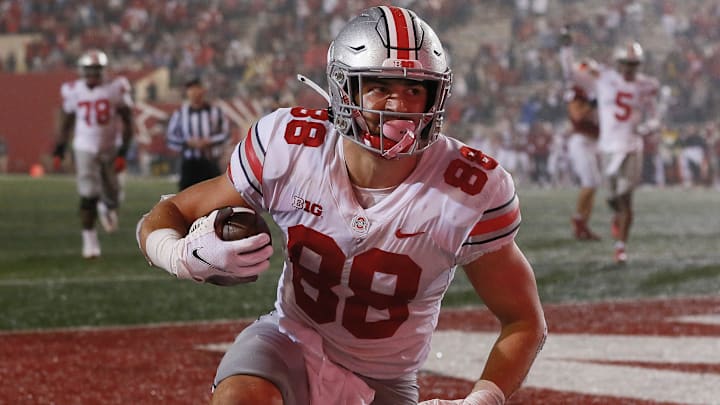
Breakdown of the Jeremy Ruckert pick for the NY Jets
Before I evaluate the pick, it is important to first analyze Ruckert as a prospect. Over the course of four seasons with OSU, Ruckert played in 26 games and logged 615 yards, much of which come from his 11 starts and 309 yards as a senior.
He caught only three touchdown passes this past season, but the counting stats are just the tip of the iceberg for Ruckert.
In terms of skills, Ruckert may be the best blocker in the class. He has great hands in addition to a powerful 6-foot-5, 250-pound frame that overpowers defenders. To boot, his route running ability is above average for the position. Overall, Ruckert really is a well-rounded player.
It isn’t all roses for Ruckert, though. His lack of production at OSU is cause for concern, especially considering the explosiveness of that 2021 Ohio State offense. Plus, his play is inconsistent, as he sometimes disappears from games.
Overall, though, Ruckert is an excellent value at pick 101. And when you’re basically in the fourth round, value and skill are the most important factors to consider when drafting a player.
Because the hit rate at that point in the draft is so low, it is likely best to just give yourself the best chance at drafting a good player, regardless of position.
Many argue that tight end is not a need, which in some ways it is not. The Jets have two capable starting tight ends on the roster.
However, not only does Ruckert have blocking skills that C.J. Uzomah and Tyler Conklin lack, but he also provides long-term value, being eight and five years younger than the two veterans, respectively.
At this moment in time, the Jets are not in desperate need of a starting tight end. However, that is not the role that Rucker was drafted to fill, nor should it have been.
Players selected around pick 100 should not be slotted to start at their respective position — doing so occurs when the general manager has built the roster poorly. The players to be had there are just not good enough.
Take the 2018 NFL Draft. From picks 85-115, only two true starters have panned out from that span: Mark Andrews and Alex Cappa, who both were selected before Ruckert’s 101 draft slot.
With a hit rate that low, a general manager should look at who has the greatest chance of panning out rather than who fills a need.
Considering that some call Ruckert the best tight end in the class and an early Day-2 talent, selecting him at pick 101 was an excellent choice by Douglas, whether or not he will have a significant role in 2022.
It’s worth noting that neither Cappa nor Andrews started as rookies despite being great players now.
